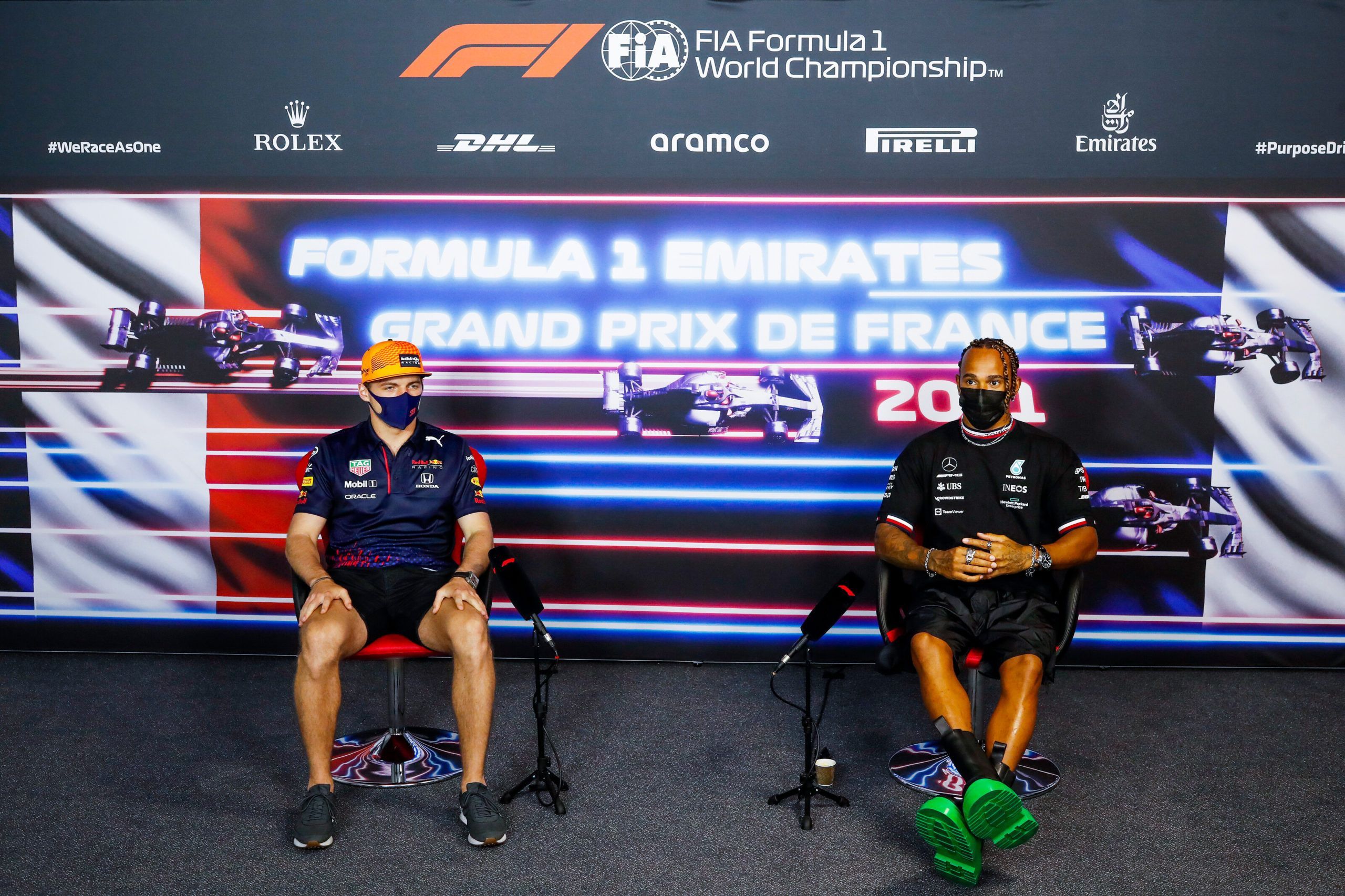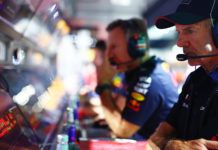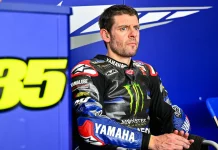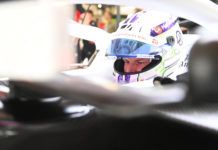F1 drivers – including Max Verstappen, Lewis Hamilton, Lance Stroll and Sebastian Vettel – spoke about the findings of Baku as Pirelli’s Mario Isola adds more on the investigations.
Starting with Red Bull’s Verstappen, the Dutchman was not too pleased with the findings from Pirelli, which indirectly put the teams in the contributing factor list, where the cause was noted as ‘running parameters’ getting disrupted to lead to eventual failure.
While both Red Bull and Aston Martin said that they followed all of the guidelines, Pirelli stuck to its case, where Isola noted that the F1 teams did not break any regulation in doing so. It seems like a legal loophole, which they found out and used to their advantage.
On the impact and worse outcome:
Verstappen: “Not so much reflection, just realising that I was actually quite lucky to hit the wall on the right hand side instead of the left, because I think if I’d have gone left it would have been a really big impact, so it was more that. Of course, I was really upset and disappointed to not win that race but on the other hand I was also quite lucky there in that instance. So, it happens. It’s racing, of course, things can happen, but of course these kinds of things you don’t want to happen.”
On Pirelli’s statement:
Verstappen: Personally, I am not happy with it, because for me it was just a bit vague what came out. The only thing I can say is that from our side, I think the team did everything like they should have done. They followed all the guidelines with tyre pressures and stuff. So there was nothing to be found there. For sure we’ll go up on pressures here for this F1 weekend. I’m 100% sure we will.
“Probably it has something to do with that, what happened in Baku, but it would also be nice to just know if it was tyre pressure related. Just speak out – it would be a bit easier to understand if that happened. I think the explanation we got so far wasn’t enough because the team did not do anything wrong.”
On integrity of tyres and confidence:
Verstappen: “Of course, they explained that they don’t have measurement tools during the race, but we gave them our tyre pressures and they were within the limits they set. If those limits are not correct, there is nothing we can do about it, we just follow what is possible within the rules. If that means that we have to go up on pressures, we will – everyone will go up on pressures. But they say they didn’t have the correct measurements, but we gave it to them after the race and it was shown that we didn’t do anything wrong.
“And also, Aston Martin didn’t do anything wrong. So, they cannot put the blame on us. I think they have to look at themselves. And we are here, happy to help of course with everything. They already went up on pressure from Friday [in Baku] to Saturday, so that means something. Maybe it wasn’t enough. We’ll go up on pressures here, for sure, and hopefully that’s enough.”
Along with Verstappen, the other F1 driver to have had to go through impact was Aston Martin’s Stroll. The Canadian felt hard but was fortunate that no one came high speed in the corner. His teammate, Vettel, meanwhile, spoke at length about the investigation.
On crash and aftermath:
Stroll: “It’s never fun having a blow-out at those speeds. It’s always scary. It’s happened to me twice now, in F1 at properly at a high speed, very unexpectedly; in Mugello back in September and then again last weekend. It’s not fun, but I think it’s one of those things you have to just put it behind you. It happened and [I’m] getting back in the car this weekend.
“I wouldn’t say I was fortunate to have it on that part of the circuit because it was still a dangerous place on the circuit to be stopped. I was a little bit worried because it’s after turn 20, which is a high-speed corner and if you’re coming through that corner, you can’t really see the car in the wall behind the corner.
“So I was a little bit concerned about some cars approaching me. I was lucky I didn’t have it on a place on the circuit where it could have been a much bigger impact. I didn’t hit the wall hard, and I was quite lucky with where it happened. It was just a high speed spin really with some contact but I’m all good.”
On his opinion of Pirelli’s investigation:
Vettel: “I don’t know the latest one, but I think the only thing that really matters, I can only speak for ourselves, obviously it happened in our team to Lance, he had a failure, we have been doing what Pirelli asked us to do. I don’t know anything else. I guess from my side or our side in that regard nothing to add.
F1 teams did nothing wrong but new directive still:
Vettel: “Well, the bottom line is that everybody gets controlled on the grid whether they are fine on pressures or not. I know that we were, so that’s the most important thing. And then I think we don’t need to debate. I think there is prescription in place. We stick to those in order to run the tyres in a safe window. When the tyre obviously fails, we need to exactly understand why that is.
“I think as I said from our side, there is probably nothing to add. But it’s also clear that the first priority should be that the F1 tyres are safe, and in a race, you have many different scenarios that a tyre needs to withstand, not real news that this can be quite challenging. You’re going at high speeds, you’re going at low speeds, you’re braking very hard, it can be very hot outside, the tarmac can be smooth or can be rough, you have safety car windows where we have to follow the safety car because there is a hazard on-track where we have to go very, very slow.
“In that scenario, the tyre pressures drop dramatically, and then you have a green flag and everybody goes flat out straightaway. So the stress on the tyres, no doubt is very, very high, but obviously it is a product that should be designed to first of all be as safe as possible. Over the last years, we’ve had plenty of occasions, I think there’s been a proper follow-up and report, but from our side, and I can think only speak for us drivers, the priority is clearly that the F1 tyres are safe. Safety has the highest priority, and everything else, every other interest, will always have to come second.”
On multiple issues with Pirelli and his confidence with integrity – Isola noted that the crash did not happened due to structure issue but he will speak with the German:
Vettel: “I don’t think I need to add a lot. As I said, the demands are very high, and it’s not always easy to get everything right. If you are thriving for the perfect product, to make everyone involved happy is probably not going to happen. But I think I’ll leave it there, I think I said enough. I think a short answer would be I can’t say 100% yes and I can’t say 100% no, regarding the confidence in integrity.
While Verstappen and Vettel seemed pretty clear with their answers, Hamilton was in two minds. From safety side, the Brit reckons the crash was not a great exhibit, but the investigations also threw out F1 teams using some tricks, which needs to be stopped.
On his view of the investigation and integrity:
Hamilton: “I’m kind of in two minds. At the end of the day, safety is always the priority. And for me and for my F1 team, there have been clear rules and guidelines as to where we have to operate. So, I was very surprised naturally to see that they had to clarify those, which obviously, you can take what you want from that. I’m happy that they have acknowledged that they need to clarify it.
“I think what’s really, really important from now is how they police it. Because they’ve not been policing how the tyres are being used, tyre pressures, tyre temperatures, and we need to do better. It’s great that they’ve done a TD, but it’s the action now we need to see them really follow through and be really vigilant to make sure that it’s equal across the field.
“I don’t have an opinion about the integrity of the tyres. As you know every weekend, whenever there is a failure, they always put the pressures up. So that tells you something, more often than not that the F1 tyres are not being run at the pressures that are being asked. We didn’t have a problem with our tyres. I think they’ve done a great job with the tyres this year, they’re more robust than before, and I think in this particular instance, I don’t think Pirelli are at fault.”
Much like in Baku, Pirelli held an extra session for media to brief them about the investigations in details. Isola spoke at length to media – including FormulaRapida.net – about various aspects, whether or not it was illegal or how to catch the F1 teams. AMid the chat, he confirmed Hamilton cut to be debris related, same as what they found on Vettel’s too.
On what happened in Baku and retrospect:
Isola: “When we propose the parameters we base it on some calculations that we make in order to use the tyre within the right parameters. So any part of the car needs to be used within parameters – the engines, brakes — and the tyres are no different to that. And so, we have these parameters that are checked before the usage of the tyres, but we don’t have control of the running conditions. What happened in Baku is simply that the running conditions expected were different compared to the actual running conditions and that created the failure.
“The failure was a circumferential cut on the inside shoulder – for both the tyres it was the same failure mode. When you have a lot of energy going into the tyres with a pressure that is lower compared to the expectation, the result is that on the sidewall you have what we call standing waves. Standing waves are putting a lot of energy into the inside shoulder of the tyre and at a certain point the tyre breaks.
“And that is what happened and the reason why we had this situation in Baku. Looking back at the F1 weekend, the rear tyre pressures should have been increased by probably another couple of psi, 1.5 or something in the range of that.”
How it works during a F1 weekend:
Isola: “When we prepare the prescriptions for minimum pressure, we receive the simulations and we consider margins. The expected loads, the downforce or the speed, are simulated, so it is not exactly the value that we find on track. And in this case in Baku, we also found some parameters that were not exactly what we found on track. We assume that they are running at a certain pressure, and a certain camber. And with a margin on it, of course, we run in a condition that is okay for the tyre.
“In that case, we didn’t achieve these conditions, not because teams were doing something against the regulations, but because they were looking as usual for performance, and that created a different scenario to what we were expecting. And the different scenario was that mainly the tyres were running at a lower pressure compared to expectation.”
No policing till now but can only come in 2022:
Isola: “Ideally what we should police, the important parameters to police for the tyres, are the running conditions. Running conditions are the running stabilised pressure, the load, the speed, the camber. Obviously some of these parameters are not enforceable simply because we don’t have the tools to do that.
“Next year, everybody knows that with the 18-inch tyres we will have a standard sensor that is provided to all the cars and is controlled by the FIA. And in that case, it is possible to police the running pressure. Right now each team is fitting different sensors and these sensors are not under control so we cannot police the running stabilised pressure. It is not because we don’t want to do that, it is simply not possible.”
No rules break from F1 teams in search of performance:
Isola: “If the regulation is not written which is the running pressure that you have to respect, I cannot say that they were doing something against the regulation in their search of more performance, because if they respect the starting pressure at the moment they are complying with the regulation. If the same happens next year when we, with a standard sensor, impose a running pressure, in that case, they are against the regulation. But this is not the case this year and it is not possible to do that simply because we don’t have a sensor where we can rely on measurements.
“Each F1 team is looking for performance. They are here racing, they are not here just to cruise on track. And that means that, looking for performance, we know that if you go with a bit lower pressure, you get some performance. We check every time the running parameters when we receive the telemetry data from the race. We check everything on all the teams, of course, and also because it’s an indication for the following race and its prescription, so we use the data.”
Here’s what Pirelli said and how F1 teams responded
Here’s Pirelli on their 2022 target letter
Here’s Max Verstappen and Pirelli on tyre blowout



















